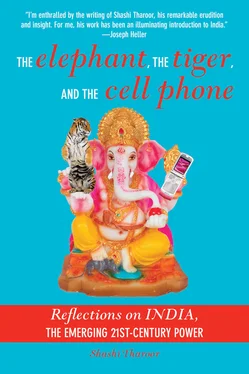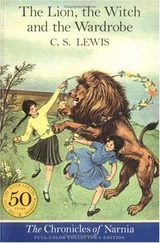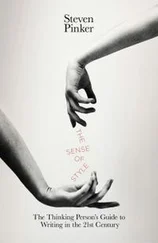But my larger and more serious point is that the French speak French, the Germans speak German, the Americans speak English (though Spanish is making inroads, especially in the Southwest and Southeast of the United States) — but Indians speak Punjabi, or Gujarati, or Malayalam, and it does not make us any less Indian. The idea of India is not based on language. It is no accident that Jawaharlal Nehru's classic volume of Indian nationalism, The Discovery of India, was written in English — and it is fair to say that Nehru discovered India in English. Indeed, when two Indians meet abroad, or two educated urban Indians meet in India, unless they have prior reason to believe they have an Indian language in common, the first language they speak to each other is English. It is in English that they establish each other's linguistic identity, and then they switch comfortably to another language, or a hybrid, depending on the link they have established. Language and religion are, in any case, an inadequate basis for nationhood. Over eighty countries profess Christianity, but they do not seek to merge with each other; the Organization of the Islamic Conference has more than fifty members, who agree on many issues but do not see themselves as a single nation. As for language, Arabic makes meetings of the Arab League more convenient, no doubt, but has hardly been a force for political unity; Spanish has not melted the political frontiers that vivisect Latin America; and England and the United States remain, in the famous phrase, two countries divided by a common language.
A more poetic suggestion made by the French historian Ernest Renan is that historical amnesia is an essential part of nation-building, that nations are those that have forgotten the price they have paid in the past for their unity. This is true of India, though the Babri Masjid tragedy reveals that we Indians are not very good at forgetting. We carry with us the weight of the past, and because we do not have a finely developed sense of historicism, it is a past that is still alive in our present. We wear the dust of history on our foreheads and the mud of the future on our feet.
So Indian nationalism is a rare animal indeed. It is not based on language (since there are at least twenty-three or thirty-five, depending on whether you follow the amended constitution or the ethnolinguists). Nor on religion, since India is a secular pluralist state that is home to every religion known to mankind, with the possible exception of Shintoism; and Hinduism — a faith without a national organization, no established church or ecclesiastical hierarchy, no uniform beliefs or modes of worship — exemplifies as much our diversity as it does our common cultural heritage. Not on geography, since the natural geography of the subcontinent — the mountains and the sea — was hacked by the Partition of 1947. And not even territory, since, by law, anyone with one grandparent born in pre-partition India is eligible for citizenship. Indian nationalism has therefore always been the nationalism of an idea.
To repeat the argument: we are all minorities in India. Indian nationalism is the nationalism of an idea, the idea of an ever-ever land — emerging from an ancient civilization, united by a shared history, sustained by pluralist democracy. India's democracy imposes no narrow conformities on its citizens. The Indian idea is the opposite of what Freudians call “the narcissism of minor differences”; in India we celebrate the commonality of major differences. The whole point of Indianness is its pluralism: you can be many things and one thing. You can be a good Muslim, a good Keralite, and a good Indian all at once. To borrow Michael Ignatieff's famous phrase, we are a land of belonging rather than of blood.
If America is a melting pot, then to me India is a thali, a selection of sumptuous dishes in different bowls. Each tastes different, and does not necessarily mix with the next, but they belong together on the same plate, and they complement each other in making the meal a satisfying repast. Indians are used to multiple identities and multiple loyalties, all coming together in allegiance to a larger idea of India, an India that safeguards the common space available to each identity.
That idea of India is of one land embracing many. It is the idea that a nation may endure differences of caste, creed, color, conviction, culture, cuisine, costume, and custom and still rally around a consensus. And that consensus is about the simple idea that in a democracy you don't really need to agree — except on the ground rules of how you will disagree.
Is such an idea sustainable in a land where 81 percent of the population adhere to one faith — Hinduism? There is no question but that the Indian ethos is infused by a pervasive and eclectic Hindu culture that draws richly from other traditions, notably Islamic ones. Recent news stories have chronicled the rise of an alternative strain in Indian politics, one that appeared to reject this consensus — that of an intolerant and destructive “Hindutva” movement that assaults India's minorities, especially its Muslims, that destroyed a well-known mosque in 1992, and conducted horrific attacks on Muslims in the state of Gujarat ten years later. The sectarian misuse of Hinduism for minority bashing is especially sad since Hinduism provides the basis for a shared sense of common culture within India that has little to do with religion. The inauguration of a public project, the laying of a foundation stone, or the launching of a ship usually starts with the ritual smashing of a coconut, an auspicious practice in Hinduism but one which most Indians of other faiths cheerfully accept in much the same spirit as a teetotaler acknowledges the role of champagne in a Western celebration. Hindu festivals, from Holi (when friends and strangers of all faiths are sprayed with colored water in a Dionysian ritual) to Deepavali (the festival of lights, firecrackers, and social gambling) have already gone beyond their religious origins to unite Indians of all faiths as a shared experience.
Festivals, mela s, lila s, all “Hindu” in origin, have become occasions for the mingling of ordinary Indians of all backgrounds; indeed, for generations now, Muslim artisans in the Hindu holy city of Varanasi have made the traditional masks for the annual Ram Lila (the dance-drama depicting the tale of the divine god-king Rama). Hindu myths like the Ramayana and the Mahabharata provide a common idiom to all Indians, and it was not surprising that when national television broadcast a ninety-four-episode serialization of the Mahabharata, the script was written by a Muslim, Dr. Rahi Masoom Raza. Both Hindus and Muslims throng the tombs and dargah s of Sufi Muslim saints. Hindu devotional songs are magnificently sung by the Muslim Dagar brothers. Hinduism and Islam are intertwined in Indian life. In the Indian context today, it is possible to say that there is no Hinduism without Islam: the saffron and the green both belong on the Indian flag.
A lovely story that illustrates the cultural synthesis of Hinduism and Islam in northern India was recounted by two American scholars. It seems an Indian Muslim girl was asked to participate in a small community drama about the life of Lord Krishna, the Hindu god adored by shepherdesses, who dance for his pleasure (and who exemplify through their passion the quest of the devout soul for the Lord). Her Muslim father forbade her to dance as a shepherdess with the other schoolgirls. In that case, said the drama's director, we will cast you as Krishna. All you have to do is stand there in the usual Krishna pose, a flute at your mouth. Her father consented, and so the Muslim girl played Krishna.
This is India's secularism, far removed from its French equivalent. Western dictionaries define secularism as the absence of religion, but Indian secularism means a profusion of religions, none of which is privileged by the state and all of which are open to participation by everybody. Secularism in India does not mean irreligiousness, which even avowedly atheist parties like the Communists or the DMK have found unpopular among their voters; indeed, in Calcutta's annual Durga Puja (the annual festival celebrating the goddess Durga, which is the Bengali Hindu's equivalent of Christmas), the youth wings of the Communist parties compete with each other to put up the most lavish Puja pandals or pavilions to the goddess. Rather, it means, in the Indian tradition, multi-religiousness. In the Calcutta neighborhood where I lived during my high school years, the wail of the muezzin calling the Islamic faithful to prayer blended with the tinkling bells and chanted mantras at the Hindu Shiva temple nearby and the crackling loudspeakers outside the Sikh gurudwara reciting verses from the Guru Granth Sahib. (And St. Paul's Cathedral was only minutes away.)
Читать дальше












